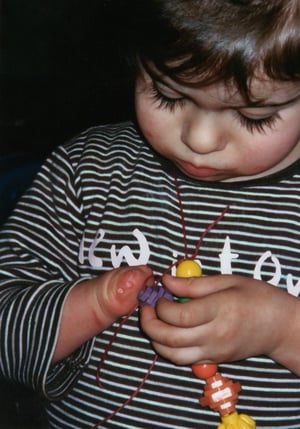Finding out that your baby is going to be born with an upper limb difference comes as a surprise to expectant parents. Questions may arise: Why did this happen to our baby? How will other children treat her/him? What can we do to help her/him?
While most congenital limb differences are discovered during a prenatal ultrasound, sometimes parents are not aware of a limb difference until their baby is born.
I cried with happiness when I found out that it was a girl and I cried again to find out that Amber would be missing a hand. But pretty quickly, even when I was still on the ultrasound table, I felt like it was going to be okay. I knew there was great prosthetic technology out there. I had seen photos and videos. –Jennifer, mother of Amber (featured in both of the photos above)
We didn't know before Lexi was born that she was not going to have her hand. We found out right when she was born and we were shocked. We knew we’d do whatever we could to help her. –Eva, mother of Lexi (photo below)
As you come to terms with this unexpected challenge, it’s comforting to know that babies who have an upper limb difference are like other newborns: beautiful, healthy and strong. Finding out early gives your family time to begin processing and accepting the situation. We have an article on our site about discussing your child's limb difference with your older children, if you have them. Your concerns will begin to ease as the weeks go by and you anticipate welcoming your baby. If your feelings are overwhelming, seek out a peer support group, private counselor or another family who has a child with a limb difference.
It’s estimated that each year in the U.S., around 2,250 babies will have congenital limb differences. About 1,500 of these are upper limb. Your doctor may be able to identify the cause of your baby’s limb difference but often, the "why" behind limb difference is unclear.
Remember that babies and toddlers are unaware of their limb differences and are remarkably accepting and adaptable. As they begin developing early motor skills like bringing objects to their mouth, rolling over and crawling, they naturally incorporate their unique upper limb. They’ll become increasingly independent over time and enjoy a spectrum of childhood activities.
We wondered "How is she going to hold a bottle, how is she going to crawl?" And everything that we thought Lexi would have a hard time doing, she was able to do. And then she’d do the next thing. We were always so surprised how easily she was able to do things. –Eva, mother of Lexi
Considering Prosthetic Options
Every child with upper limb difference has an arm or hand with its own distinct characteristics. The level of limb absence usually determines at what age a child may be fit with a prosthesis. If a limb absence falls between the shoulder and the wrist, Arm Dynamics prosthetists generally recommend fitting the child with a passive prosthesis around six months of age.
We usually move the baby into an active grasp prosthesis at 12 to 18 months.
For babies with partial hand absence or finger absence, fitting a prosthesis usually begins when they’re older, between three and five years of age. These would be custom silicone devices and possibly wrist-driven devices that help the child with reaching developmental milestones.
Sometime parents are concerned that their child’s rapid growth means they won’t be able to wear their prosthesis for very long and replacements will get expensive. Children do need to be refit at regular intervals due to growth, but upper limb prosthetic specialists can often make modifications to the prosthesis to help it last for several years. For example, prosthetic sockets— the part of the prosthesis that connects to the body — can be made to expand as your child grows, often allowing them to wear the prosthesis for several years between fittings.

We recommend that you consult with an upper limb prosthetic specialist and clinical therapy specialist a few months after your baby is born. Having your child evaluated in person is an excellent opportunity to ask questions and learn about the prosthetic options that are most appropriate for their unique limb.
At 8 years old, Amber is able to do anything other kids her age do. It’s great to just watch her running around playing chase with her friends, so full of life and loving what she’s doing, with no thought to the fact she has an upper limb difference. –Jennifer, mother of Amber
Learn more about congenital upper limb difference:









%20President%20and%20Senior%20Clinical%20Director.jpg?width=600&height=600&name=John%20M.%20Miguelez%2c%20CP%2c%20FAAOP(D)%20President%20and%20Senior%20Clinical%20Director.jpg)










Comments (2)